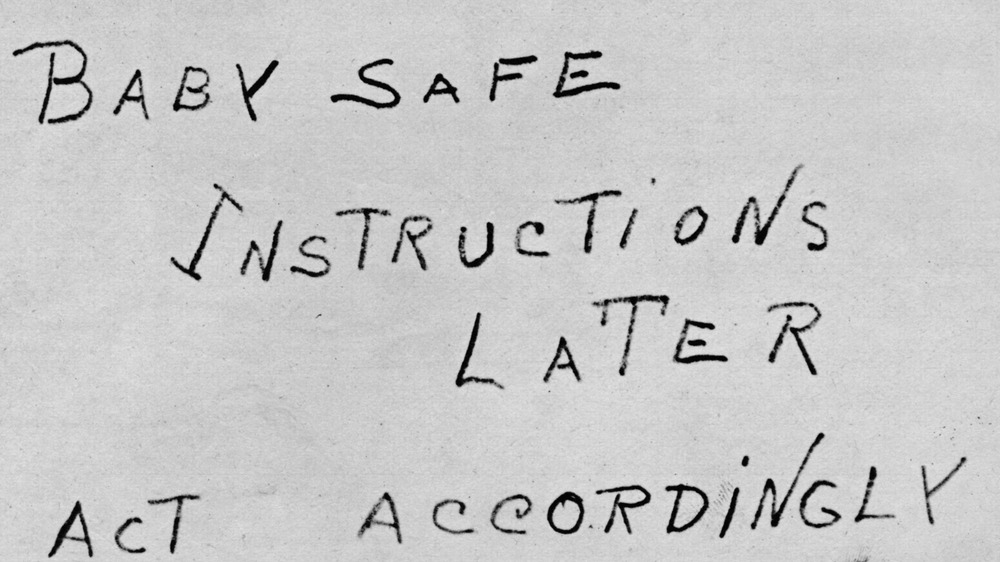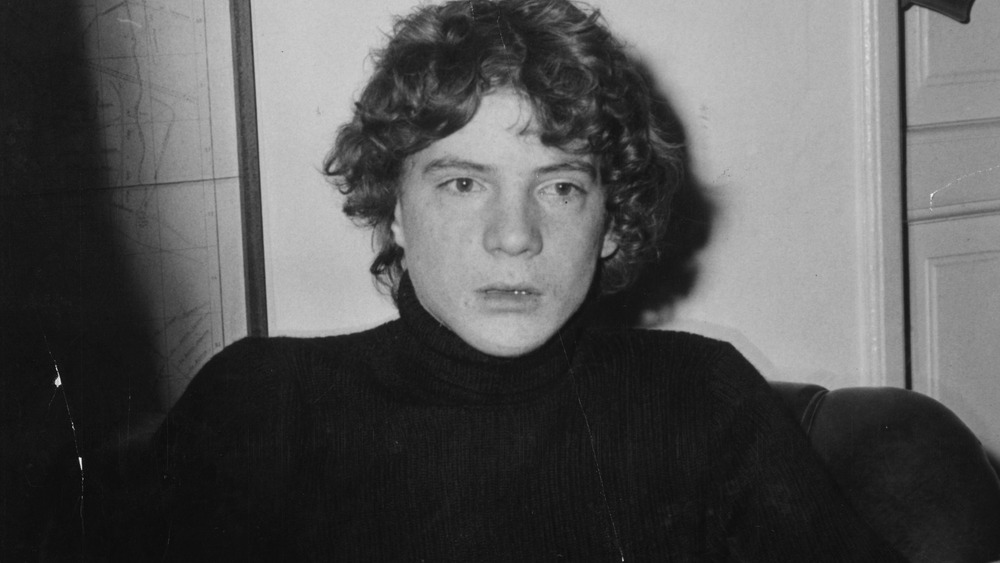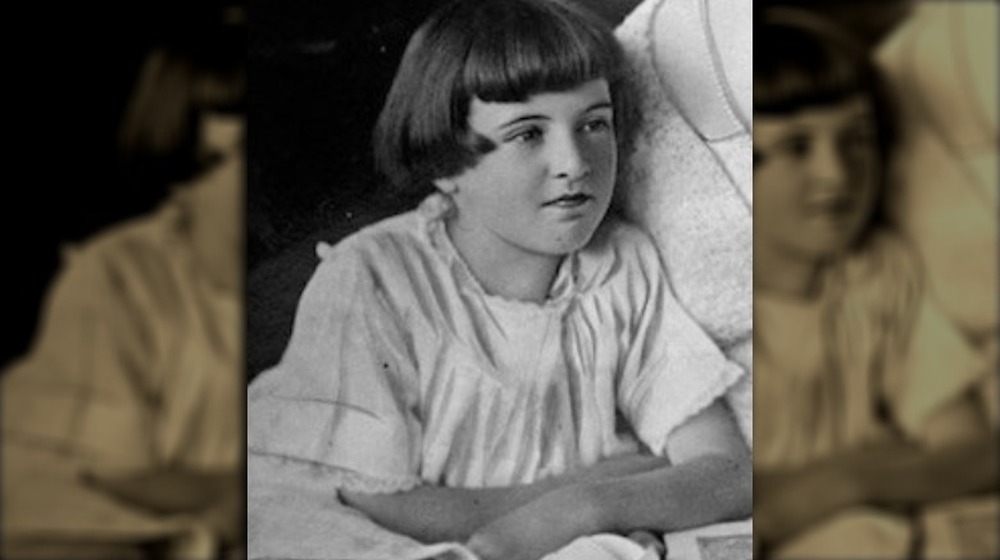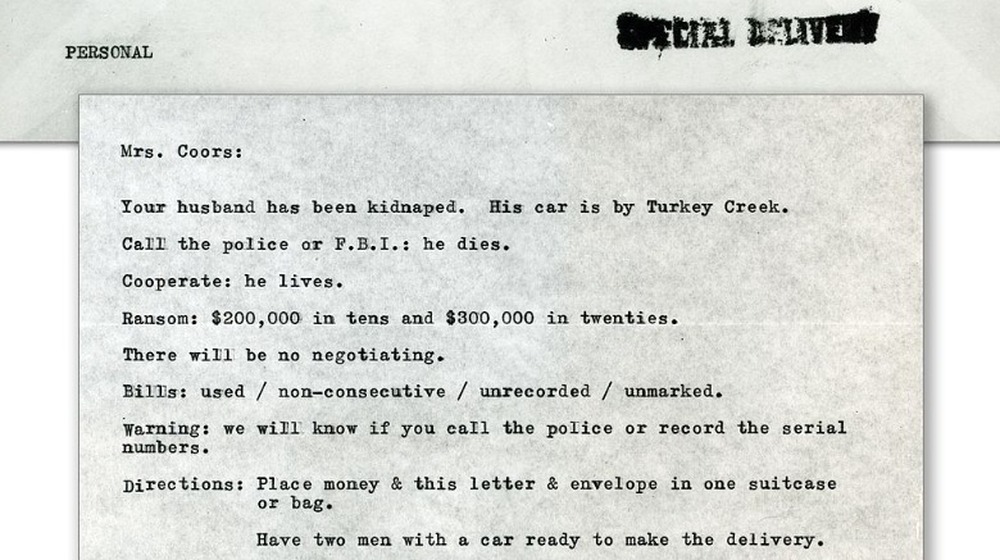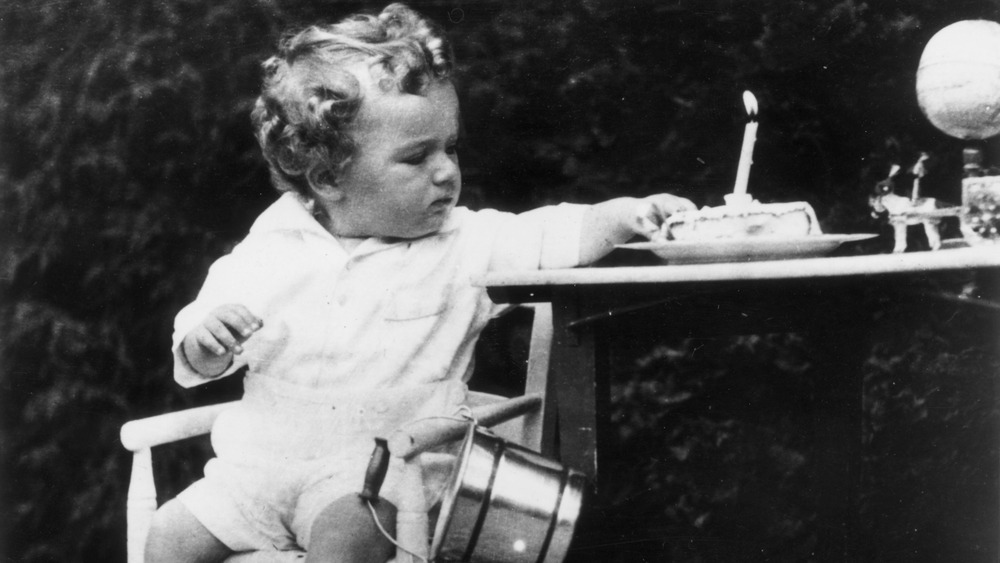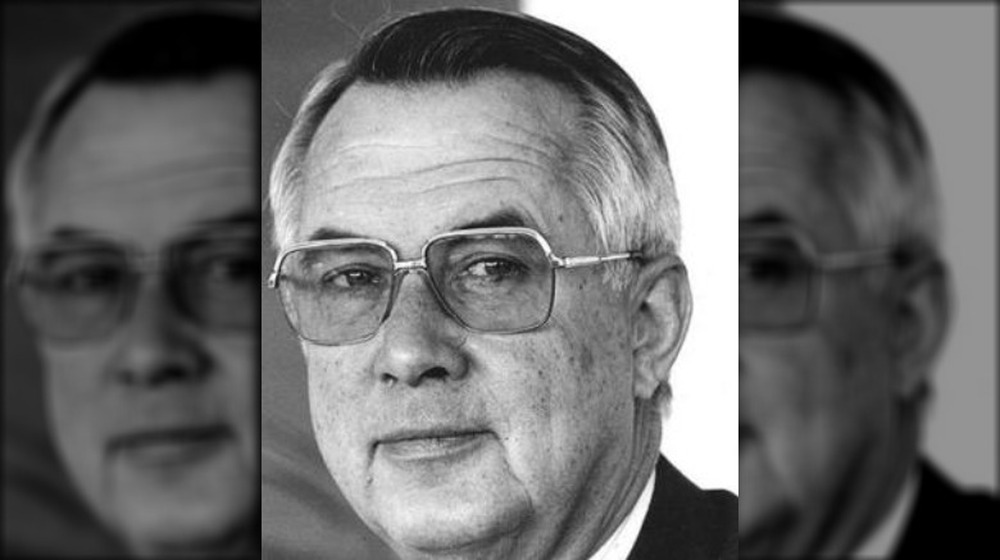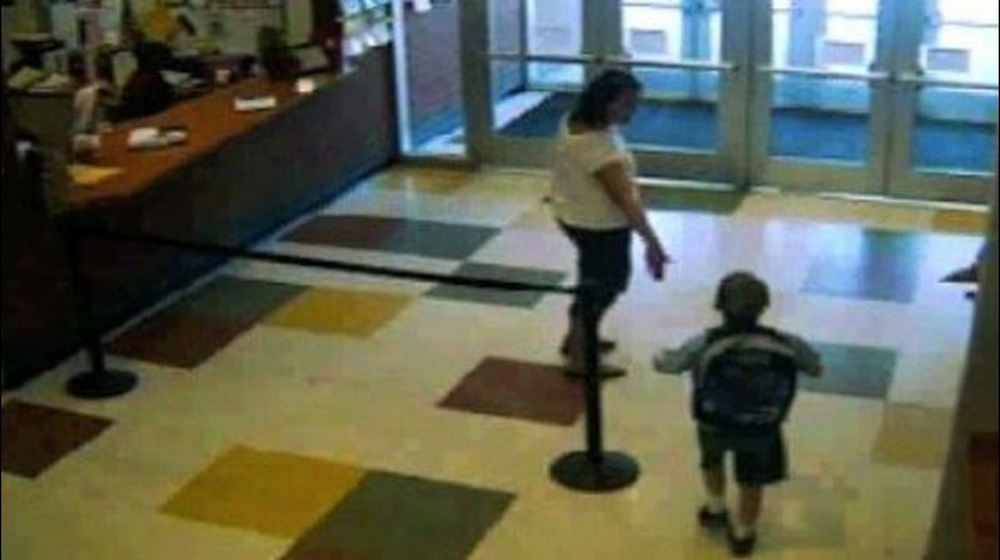The Most Disturbing Things Found In True Crime Ransom Notes
Kidnapping has been a thing for a long, long time, but according to the Smithsonian, ransom notes are a fairly new addition to the whole process. In 2013, a librarian who was going through some family records stumbled across an incredible piece of history: America's first ransom note. It had been addressed to a man named Christian Ross, and demanded that he pay the kidnapper a whopping $20,000 for the return of his son, Charley. (It's also worth noting that the year was 1874 — and accounting for inflation, the kidnappers were essentially demanding today's equivalent of about half a million dollars.)
The whole story is pretty heartbreaking, from the brand-new police department's complete inability to help, to the scores of con men and spiritualists who tried to cash in on a grieving family, to the ultimate bad ending. In spite of the fact that more than half a million people participated in search efforts, Christian and Sarah Ross never saw Charley again.
Since then, kidnapping has just become even more popular — and so have ransom notes. Some are simple lists of demands, but others are even more disturbing than that.
A severed ear
J. Paul Getty was officially named as the richest man in the US in 1957, says the Independent, and it's not entirely surprising that the Getty family became a major target. Fast forward to 1973 and Getty grandson J. Paul Getty III (pictured), who was already known as something of a wild child. When his mother got a phone call one July night, she learned just who he'd gotten the attention of: the Italian mafia. The true target — the richest Getty of them all — wasn't that concerned, and let's explain with this not-so-fun fact (courtesy of Rolling Stone): when J. Paul Getty's youngest son died from a brain tumor, he couldn't be bothered to go to the 12-year-old's funeral. So, when his grandson turned up missing, it's not entirely surprising he refused to pay.
Four months went by, with the 16-year-old Getty III in captivity. That's when things got bloody: his captors sliced off his ear, and put it — along with a lock of his hair — in an envelope with a ransom note that read, "This is Paul's ear. If we don't get some money within 10 days, then the other ear will arrive. In other words, he will arrive in little bits."
Getty III was released a month later, and was ultimately disowned for turning to a life of drugs and alcohol. Partially blind and semi-dependent on a wheelchair after his kidnapping ordeal and mutilation, he died in 2011 at just 54-years-old.
False hope, confusion, and the real cause of death
Dorothy Ann Distelhurst would have just started kindergarten when she disappeared in September of 1934. When the news went public, that's when the ransom letters started to show up at her parents' home. And there were so many that the Library of Congress described the family as being "bombarded" by them.
What are desperate parents to do? Dorothy's father, Alfred, believed three letters that claimed she and her kidnappers were in New York. According to the Associated Press, he left their Nashville home, went to NY, and did as they bid, taking out newspaper advertisements that read, "Dorothy, come home, father in New York at same place, room 1736. Please write."
She wasn't in New York at all, and the letters he'd been following — that demanded a $5,000 ransom for her return — were among the fakes. On November 14, papers were reporting that Dorothy had been found, buried in a shallow grave in Nashville. Pathologists determined (via The New York Times) that she had suffered several blows to the head, and that her face had been badly burned with acid. When officers went back through the ransom notes the family had received, they found the real one: it had shown up a week after she went missing, and the kidnappers had said they would "burn her eyes with acid," unless they were given $175,000. The real letter had disappeared among the fake ones.
An explanation of eerie phone calls
The 1980s were a different time, and Ursula Herrmann's parents didn't really think anything of their 10-year-old daughter riding her bike home from her cousin's house at 7:30 pm. She was alone, sure, but it was just a 10-minute ride. She never made it, and by the time they were out looking for her half an hour later, she had vanished.
That, says The Guardian, was Tuesday, September 15, 1981. It wasn't long before neighbors in their town of Eching, Germany, were all out looking for her, but found no trace. Then, on Thursday, something unsettling started to happen. The Herrmann's house phone would ring, and when it was picked up, the only thing that would play was the same jingle that a local radio station would play before their traffic bulletins. Then, the caller hung up. It kept happening, and the ransom note showed up the next day. It said that the kidnappers would call, play the jingle, and her parents were to say whether or not they would pay. When the next phone call came, they agreed — but it was too late.
She was found 19 days later, where she had been buried in a small box stocked with food and outfitted with a ventilation system. There was no circulation, though, and it was estimated that she had died just a few hours after being buried. In 2019, her family was still struggling to get closure, and see justice done.
The kidnapping of Baron Edouard-Jean Empain
When the industrialist Baron Edouard-Jean Empain was kidnapped in 1978 from just outside of his Paris home on Avenue Foch (pictured), it quickly became clear that his captors weren't concerned about his comfort. For the 63 days of his captivity, the BBC says he was starved, regularly beaten, and kept chained up in a dark room.
When he first disappeared, there were all kinds of theories about motivation. France 24 says that it was simply about money — and the Empain family had plenty, as they had built the Paris Metro and railways across Africa. When the ransom note came, not only did it contain demands for an amount of money that would be the equivalent to around $60 million in today's economy, but it also contained Empain's left little finger.
This one has an odd ending, and it started when law enforcement ambushed some of the kidnappers after promising to hand over the cash. One — Alain Caillol — was able to bargain with his own fellow kidnappers to arrange Empain's release, and afterwards, he reached out to his victim to apologize. Empain forgave them, but by this time, his name had been dragged through the public mud. Less-than-admirable parts of his life — like his infidelity — became public knowledge, and he was described as "a completely broken man," when he died in 2018.
The last words of a kidnapped girl
In 1927, a dapper young man strolled into Los Angeles's Mount Vernon Junior High School. He had some horrible news: local banker Perry Parker had been in a terrible car accident, and he was requesting that he see his daughter, Marion. School officials found the 12-year-old girl, handed her over to the man, and they disappeared. When her twin sister returned from school alone, it was quickly obvious that something was horribly wrong.
According to Medium, two telegrams showed up almost immediately, confirming that she had been kidnapped. The ransom note appeared the following day, with demands for $15,000 in gold certificates (which today would be worth around a quarter of a million dollars.) Two more ransom notes followed, and one postscript was from Marion herself. She wrote: "Daddy, please do what this man tells you, or he'll kill me if you don't. Your loving daughter, Marion Parker."
They would end up being her last words. Her father handed over the cash, and Marion was kicked from the kidnapper's car as they sped away. When her father went to pick her up, he realized that her arms and legs had been removed; later, the coroner discovered she had been completely disemboweled and filled with rags, her eyes sewn open. He estimated that she had been killed just 12 hours after her disappearance. A former employee of Perry Parker's — William Edward Hickman — was arrested, and confessed.
When the kidnapper and killer is family
Anyone who doubts the importance of proper spelling should take note of a 2020 story from India. It starts, says Vice, when an 8-year-old boy was kidnapped from his grandmother's home. When the family received the ransom note via text message, it contained two very specific misspellings: "police" was written as "pullish," and the area of the requested drop-off, Sitapur, was spelled "Seeta-Pur."
Investigators used a combination of eyewitness statements, cell phone tracking technology, and surveillance videos to narrow down the suspect pool to just 10 men. Knowing they were looking for someone who was just semi-literate, they (via the Times of India) asked each one of the suspects to write out the sentences, "I want a police job. I can run from Hardoi to Sitapur."
It was the 22-year-old Ram Pratap Singh who misspelled "police" and "Sitapur" in the same way they had been misspelled on the ransom note, and he was immediately arrested for the boy's disappearance and ultimately, his death. The footnote to this: Singh was the boy's distant cousin.
False hope when the victim was already dead
By the 1960s, the Adolph Coors Company was in the hands of the well-liked grandson of the brewing company's original founder. Simply known as "Ad," Adolph Coors III lived on a ranch in Denver. On February 9, 1960, he fed the horses, made sure they had water, then said goodbye to his wife and children and headed to work. Roadwork forced him to take a detour, and it was along the detour that he disappeared.
Longreads says that what followed was one of the largest search efforts in the country's history. Everyone from locals to J. Edgar Hoover were involved, and when the ransom note showed up two days later, it demanded half a million dollars. The signal that the money was ready was to be a tractor ad placed in the Denver Post, and more instructions would follow once the ad ran.
Ad's wife, Mary, was overjoyed to get the ransom note. It meant there was a chance she would see her husband again, she believed, but she would not: the ransom note that would help police link Joseph Corbett Jr. to the disappearance and death of Ad Coors had been sent after his murder. He had fought with Corbett as Corbett accosted him on the lonely, winding, Colorado road, and was shot and killed as he tried to escape in the kidnapper's car.
In the victim's handwriting
Douglas Mueller was just 19-years-old when he disappeared in 1977, and according to The Arizona Republic, it wasn't long after he finished working his shift at the local gas station that his parents knew something was wrong.
First, they were told to head to a Scottsdale pay phone, where the kidnappers would contact them with information on how to pay the ransom and get their son back. They did, but not by calling them: in the phone booth were Mueller's driver's license, and a note specifying an amount and a drop-off point for the cash. Worst of all, the note was written in a very familiar hand: the kidnappers had made the teenager write it himself.
The family paid not only that ransom, but two subsequent demands, but here's where things sort of go off the rails. The kidnappers didn't show up to collect the money at any of the three arranged meetings, and it wasn't long after that Mueller's car turned up at the Phoenix airport. Now, fast forward a full 30 years, to 2007. That's when hikers found a femur along a trail in Scottsdale, and it's also when a DNA match confirmed the bone was Mueller's. The circumstances of his disappearance and death remain unknown, and the City of Scottsdale is still looking for information on what happened to Mueller... and why he wrote his own ransom note.
A desperate plea from an elderly woman
Robert and Annie Laurie Hearin had been married for 50 years when she disappeared from their Mississippi home in 1988, and right from the beginning, things didn't look promising. The Los Angeles Times reported that the 72-year-old Hearin suffered from a severe intestinal disease that would become fatal if it remained untreated, and when she vanished, there was blood found in her home, along with a ransom note.
The note instructed Robert Hearin (a businessman worth around $200 million) to pay the ransom out to 12 different people, who WLBT says had all been sued by Hearin in the past. Hearin paid the money, and as he did, another note showed up in the mail. This one was written by Annie Laurie herself, and it's heartbreaking. "Bob," she wrote (via the Tampa Bay Times), "if you don't do what these people want you to do, they are going to seal me up in the cellar of this house with only a few jugs of water. Please save me, Annie Laurie."
That note was eventually linked to one of the 12 ransom recipients, a man named N. Alfred Winn. He headed to trial and was found guilty of the kidnapping, but in the end, Annie Laurie — or her remains — were never found, and there were no murder charges. She was declared dead in 1991, the year after her husband died.
The identity of the man behind the nation's most high-profile kidnapping
One of the most high-profile kidnapping cases in American history is the abduction of aviator Charles Lindbergh's son. According to the FBI, the basics are this: the 20-month-old baby was taken from his nursery on March 1, 1932, and a ransom note was left behind. The kidnappers wanted $50,000 (or about a million dollars in today's economy) for his return. That was increased to $70,000 in the second ransom note, and the search for the boy was massive. Several more ransom notes followed, and on May 12 of the same year, the baby's remains were recovered just over four miles from the Lindbergh home. It was estimated that he was killed almost immediately after being taken.
It wasn't until 1934 that law enforcement started getting hits on the ransom money as it was spent across different areas of New York City. They eventually traced the gold certificates to a man named Bruno Hauptmann, and here's where the ransom note comes in.
According to Northwestern University, one of the major pieces of evidence against him was his handwriting. The multiple ransom notes he'd sent gave law enforcement a wide range of samples that were matched up to Hauptmann's distinctive penmanship, and he was found guilty. Appeals were denied, and his death row sentence was carried out in April of 1936.
The finger of a dead man
While US shoppers might be completely familiar with, say, Wegmans, Kroger, or even Winn-Dixie, there's another grocery store chain that dominates in the Netherlands, and that's Albert Heijn. In 1987 — the year Gerrit Jan Heijn disappeared — Albert Heijn was the nation's largest grocery, and the Associated Press says that the kidnapping of their patriarch made a lot of high-profile public individuals rethink the whole idea of security.
Albert Heijn's vice-president was grabbed off the street outside his home, and when the ransom note showed up, it demanded $4 million in cash. Heijn's family asked for proof that he was still alive, and they learned very quickly who they were dealing with: his little finger showed up in the mail. The ransom was paid, and then... nothing.
According to the Los Angeles Times, it was another seven months before his body was recovered, where he had been buried in a wooded area in a nearby town. He had been shot and killed on the same day he was kidnapped, and that finger? When Ferdi Elsas was arrested after being caught spending some of the ransom money, he said that he had killed Heijn then cut off his finger just in case the family wanted proof, and it stayed fresh in his fridge for a few months. Elsas was found guilty and sentenced to just 20 years in jail.
A promise he'd never be found
This one is a little different, and the note left behind wasn't a demand for something in exchange for a life, it was a simple message that the child in question would never be found. It started, says Cincinnati, in May of 2011. That's when Amy Fry-Pitzen picked her son Timmothy up from school in the middle of the day, and headed out on what turned out to be a spur-of-the-moment vacation. After telling her mother they just needed a few days to have some fun, they went to a waterpark and a zoo. They're on surveillance footage, strolling along hand-in-hand, Timmothy with some new toys and a smile on his face.
The last footage showing the kindergartener was dated May 13, and although his mother shows up at a grocery store later that night, he was no longer with her. Then, the following morning, a housekeeper found her body — she had committed suicide, and left behind a chilling note. She wrote that Timmothy was (via the Chicago Tribune) "with people who love him and will care for him," and that "You'll never find him."
Amy's husband — and Timmothy's father — Jim issued an immediate plea for information regarding the whereabouts of his son. Although some people have claimed to be the missing boy — including, says CNN, one man later identified as Brian Rini — no one has seen or heard from Timmothy since his mysterious disappearance. His mother's cryptic note, it seems, was right.
